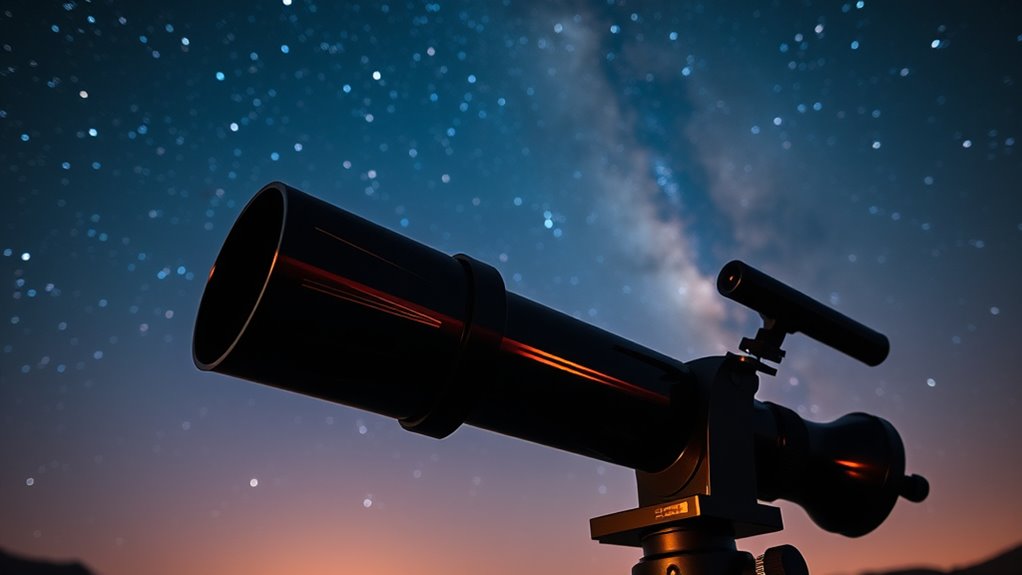If you’re looking to boost your astrophotography, choosing the right field flattener makes a big difference. I recommend options like the Explore Scientific Field Flattener, SVBONY SV193 Focal Reducer, and HOTECH SCA 2 Inch Flatener, which are known for sharp, distortion-free images with high-quality coatings and flexible compatibility. Each offers features tailored for different telescopes and setups. Stay with me to discover more about the top flatteners that can transform your astrophotography results.
Key Takeaways
- High-quality flatteners reduce field curvature and star distortion, resulting in sharper, more pinpoint stars across the entire image.
- Compatibility with various focal ratios (f/5 to f/8) ensures optimal performance for different refractor telescopes.
- Fully multi-coated optics maximize light transmission, contrast, and color fidelity for clearer astrophotography images.
- Precise back focus adjustment and secure mounting are essential for achieving a flat, distortion-free field.
- Popular models like Explore Scientific, SVBONY, and HOTECH offer reliable performance and versatile features for astrophotographers.
Explore Scientific Field Flattener for Refractor Telescopes

If you’re serious about astrophotography with your refractor telescope, the Explore Scientific Field Flattener is a top choice because it effectively reduces star distortion caused by field curvature. When placed between your telescope and camera, it ensures sharp, pinpoint stars across the entire image, not just the center. Designed specifically for focal ratios from f/5 to f/7, it offers maximum performance within this range. Its fully multi-coated optical glass maximizes light transmission, delivering high-contrast images of celestial objects. Plus, with a secure T-ring attachment, it’s compatible with various camera models. Made in the USA, it also comes with reliable customer support for peace of mind.
Best For: astrophotographers using refractor telescopes with focal ratios between f/5 and f/7 seeking sharp, high-contrast images with minimized star distortion.
Pros:
- Effectively reduces star distortion caused by field curvature for sharp, pinpoint stars across the entire image field
- Fully multi-coated optical glass maximizes light transmission and enhances image clarity and contrast
- Secure T-ring attachment ensures compatibility with various camera models and stable setup
Cons:
- Designed specifically for focal ratios of f/5 to f/7, limiting use with other telescope configurations
- Requires precise spacing of 55mm (+/- 2mm) from camera sensor, which may need careful adjustment
- May be less effective if used outside the specified focal ratio range or with non-refractor telescopes
SVBONY SV193 Focal Reducer for Telescopes
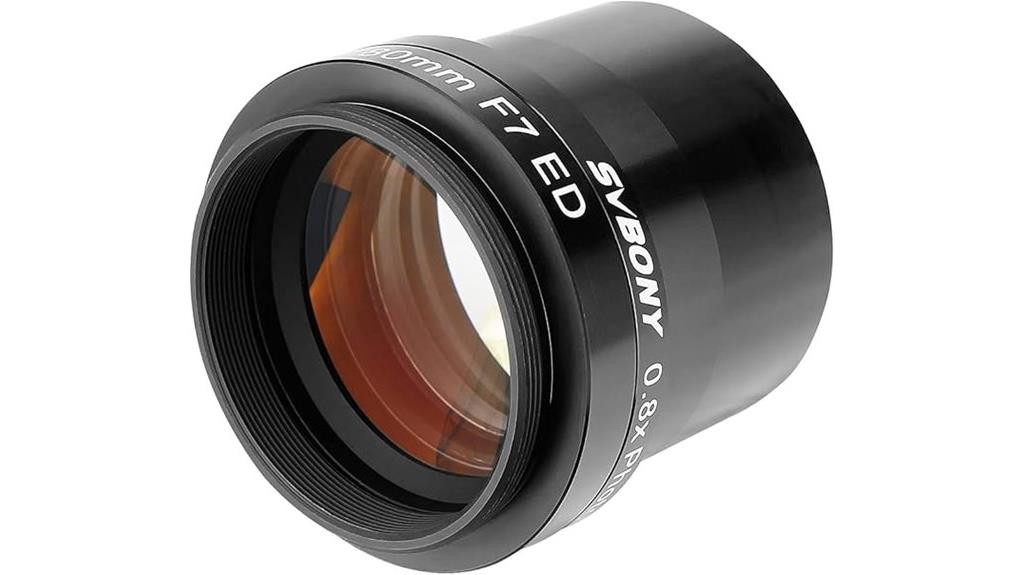
The SVBONY SV193 Focal Reducer for Telescopes stands out as an excellent choice for astrophotographers aiming for sharp, distortion-free images across the entire field of view. It reduces focal length by 0.8x and flattens the field, minimizing star distortion at the edges. Compatible with the SV503 80mm F7 ED telescope, it supports full-frame cameras through its M48 threaded connection and features a standard 2-inch filter thread for added flexibility. This focal reducer not only shortens exposure times but also enhances image quality, making it an essential accessory for capturing detailed, high-quality astrophotos with refractor telescopes.
Best For: astrophotographers using refractor telescopes seeking to achieve sharp, wide-field images with minimal star distortion and shorter exposure times.
Pros:
- Reduces focal length by 0.8x for wider field imaging
- Flattens the field to minimize star distortion at the edges
- Compatible with full-frame cameras and supports standard filters
Cons:
- Designed specifically for certain telescope models like SV503 80mm F7 ED, limiting universal compatibility
- Requires proper threading and attachment, which may involve additional adapters for some setups
- May slightly reduce brightness due to focal reduction, affecting imaging in very low-light conditions
SVBONY SV209 Field Flattener, 0.8X Focal Reducer for Telescope

Designed specifically for astrophotographers using the SV550 122mm APO refractor, the SVBONY SV209 Field Flattener effectively converts the telescope’s native 854mm focal length into a faster, wider 683.2mm (f/5.6), making it ideal for capturing sharp, wide-field images. It corrects field curvature, ensuring sharp focus across the entire frame, including the edges. With a secure screw-in attachment and compatibility with DSLR and CCD sensors, it enhances image quality and efficiency. Weighing just 15.8 ounces, it’s a lightweight, reliable tool that considerably improves flat-field imaging, making it a valuable addition for serious astrophotographers.
Best For: astrophotographers using the SV550 122mm APO refractor aiming to achieve sharp, wide-field images with improved flatness and faster focal ratios.
Pros:
- Effectively converts 854mm focal length to a faster 683.2mm (f/5.6), enabling wider field imaging.
- Corrects field curvature for sharp, focused images across the entire frame, including edges.
- Secure screw-in attachment ensures stable and reliable connection to telescope and sensors.
Cons:
- Variability in extension tube measurements can affect backspacing and focus, requiring precise adjustments.
- Some users may experience compatibility issues with certain extension tubes or accessories.
- Slightly heavier than some similar accessories, which could impact balance for some setups.
HOTECH SCA 2 Inch Field Flattener for Refractor Telescopes

For astrophotographers seeking sharp, distortion-free images across their entire field of view, the HOTECH SCA 2 Inch Field Flattener offers an excellent solution. Designed for refractor telescopes with focal ratios from f/5 to f/8, it features a fully multi-coated two-element lens that guarantees bright, crisp images edge to edge. Its compatibility with standard 2″ filters and all 35mm T-rings makes it versatile and user-friendly. The built-in T-adapter center load system simplifies camera alignment, while the compression and rubber rings assure precise positioning. Overall, it’s a reliable choice for achieving high-quality astrophotography results with minimal hassle.
Best For: astrophotographers using refractor telescopes with focal ratios between f/5 and f/8 seeking sharp, distortion-free images across the entire field.
Pros:
- Fully multi-coated two-element lens ensures optimal light transmission and sharp images.
- Compatible with standard 2″ filters and all 35mm T-rings for versatile imaging options.
- Built-in T-adapter center load system simplifies camera alignment and precise positioning.
Cons:
- Designed specifically for refractors with f/5 to f/8, limiting use with other telescope types or focal ratios.
- Slightly higher price point compared to basic adapters, which may be a consideration for budget-conscious users.
- Customer reviews are limited, so long-term durability and performance details are less widely documented.
SVBONY Focal Reducer for SV503 102mm ED Telescope

If you’re serious about astrophotography with your SV503 102mm ED refractor, the SVBONY Focal Reducer is a must-have accessory that can significantly enhance your images. It offers 0.8x focal reduction and field flattening, ideal for full-frame astrophotography, resulting in wider views, finer star points, and better signal-to-noise ratio. Made with durable, multi-coated optics and a lightweight aluminum body, it’s easy to attach via standard threads. Keep in mind, proper focus may require removing the included nose piece, and some setup experimentation is needed for ideal flat field results. Overall, it’s a valuable upgrade for improving image quality and expanding your sky coverage.
Best For: astrophotographers using the SV503 102mm ED refractor telescope who want wider field views and improved image quality for full-frame astrophotography.
Pros:
- Provides 0.8x focal reduction and field flattening for wider and sharper images.
- Made with durable, multi-coated optics and lightweight aluminum construction.
- Easy to attach with standard threads and suitable for various setups with removable nose piece.
Cons:
- Proper focus may require removing the included nose piece, which can be confusing.
- Achieving optimal flat field results may require experimentation and setup adjustments.
- Compatibility with some telescope models may need careful setup or additional adapters.
SVBONY SV503 Refractor Telescope with Built-in Field Flattener

The SVBONY SV503 Refractor Telescope with Built-in Field Flattener stands out as an excellent choice for astrophotographers seeking sharp, distortion-free images across wide fields. Its optical design includes a built-in field flattener that completely eliminates field curvature, making it ideal for capturing large, detailed deep-sky objects. The scope features ED glass, reducing chromatic aberration for true-to-life colors and high clarity. With a fast F/6.78 focal ratio and a 70mm aperture, it delivers bright, crisp images. The dual-speed focuser provides precise control, while the included 0.8x reducer extends its versatility. Overall, it offers professional-quality imaging in a compact, reliable package.
Best For: amateur astronomers and astrophotographers seeking high-quality, wide-field images with minimal distortion and chromatic aberration in a compact and reliable scope.
Pros:
- Exceptional flat-field correction with built-in field flattener for distortion-free wide views
- High optical quality with ED glass to reduce chromatic aberration and deliver true-to-life colors
- Solid construction with precise focusing mechanisms, suitable for both visual and astrophotography use
Cons:
- Slight corner star distortion when using focal reducers, which may require post-processing
- Limited aperture size compared to larger scopes, affecting deep-sky object brightness in some cases
- Focal ratio of F/6.78 may be less ideal for some specialized astrophotography needs compared to faster scopes
Astromania 2 Field Flattener for Astronomy Photos

Designed to deliver pin-sharp stars across the entire image field, the Astromania 2 Field Flattener is ideal for astrophotographers using refractor telescopes with focal ratios between f/4 and f/8. It effectively corrects field curvature, ensuring flat, distortion-free images. The M48 threading supports full aperture illumination, while the 109mm back focus allows for easy accessory integration. With high-quality multi-coated lenses, it maximizes light transmission and minimizes reflections, resulting in clearer, brighter images. Weighing just 8.8 ounces, it’s lightweight and easy to handle, making it a reliable choice for enhancing astrophotography results.
Best For: astrophotographers using refractor telescopes with focal ratios between f/4 and f/8 seeking to achieve flat, sharp images across the entire field.
Pros:
- Corrects field curvature for distortion-free images across the entire frame
- Supports full aperture illumination with M48 threading for optimal light transmission
- Lightweight and easy to handle at only 8.8 ounces, suitable for portable setups
Cons:
- Compatible only with telescopes within the f/4 to f/8 focal ratio range
- May require additional accessories to reach the full 109mm back focus
- Limited information on compatibility with non-refractor telescopes or specialized camera setups
SVBONY SV503 Refractor Telescope, 102mm F7 Achromatic Refractor OTA

For astrophotographers seeking sharp, distortion-free images across the entire field of view, the SVBONY SV503 Refractor Telescope offers an excellent platform, especially when paired with a high-quality field flattener. Its 102mm aperture and F7 focal ratio deliver detailed planetary and deep-sky images. The doublet achromatic lens made from S-FPL51 ED glass minimizes chromatic aberration, while fully multi-coated optics maximize light transmission and contrast. The dual-speed focuser and 360° field rotator make fine focusing and framing easy. Compact and durable, this telescope is ideal for astrophotography, terrestrial viewing, and planetary imaging, delivering crisp, vibrant images across the entire field.
Best For: Amateur astrophotographers and planetary observers seeking high-quality, distortion-free images with precise focusing and framing capabilities.
Pros:
- High-quality doublet S-FPL51 ED achromatic lens reduces chromatic aberration for sharp, vibrant images
- Fully multi-coated optics maximize light transmission, contrast, and image brightness
- Dual-speed rack and pinion focuser combined with 360° field rotator allows precise focusing and seamless framing
Cons:
- May require additional accessories like a field flattener for optimal deep-sky imaging
- Relatively compact design might limit some advanced astrophotography setups
- Limited to 102mm aperture, which may be less suitable for very faint deep-sky objects compared to larger telescopes
SVBONY SV193 Focal Reducer 2 Inch 0.8X Field Flattener

If you’re looking to improve the quality of your astrophotography with a refractor telescope, the SVBONY SV193 Focal Reducer 2 Inch 0.8X Field Flattener is a top choice because it effectively reduces focal length and corrects field curvature, resulting in sharper, flatter images across the entire frame. Compatible with full-frame cameras and featuring a standard 2-inch front socket with M48x0.75 threading, it’s versatile and easy to attach. Its optical performance minimizes star distortion at the edges, making it ideal for capturing wide-field deep-sky objects and planetary details. Paired with high-sensitivity cameras, it delivers cleaner, more detailed images for both amateur and advanced astrophotographers.
Best For: amateur and professional astrophotographers seeking to enhance image sharpness, reduce focal length, and correct field curvature for wide-field deep-sky and planetary imaging.
Pros:
- Effectively reduces focal length by 0.8x, enabling wider field capture
- Corrects field curvature for sharper, flatter images across the entire frame
- Compatible with full-frame cameras and standard 2-inch telescope setups
Cons:
- May require precise alignment to achieve optimal image quality
- Built-in threading may not fit all telescope models without additional adapters
- Slightly adds to the overall optical train, potentially increasing setup complexity
SVBONY SV503 Portable Telescope Tube, 70ED F6 Optical Tube for Astronomy
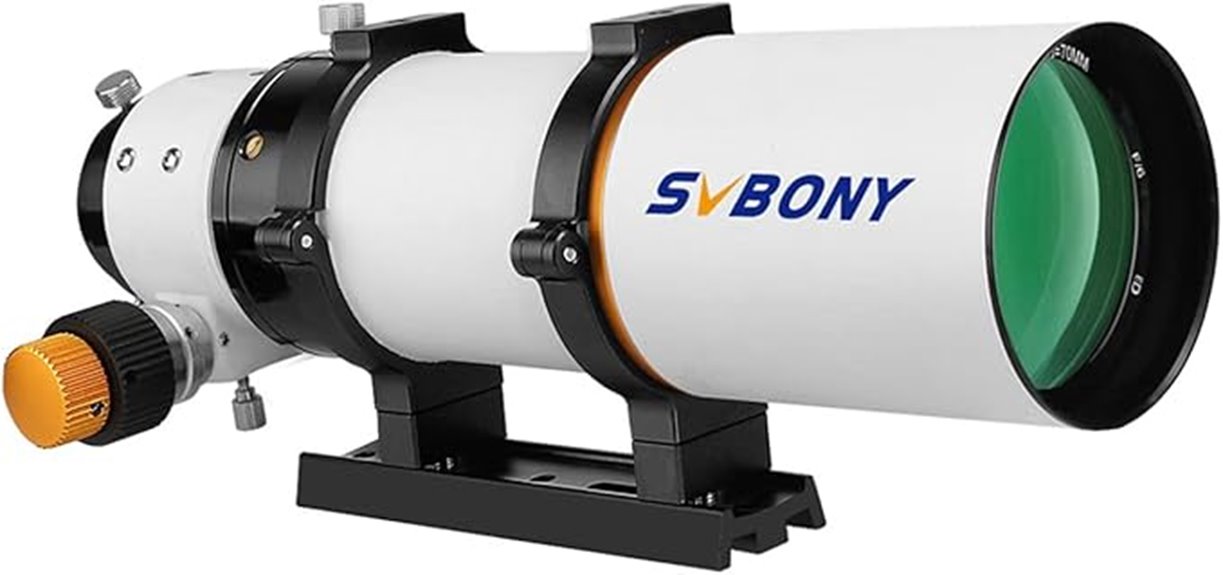
Looking for a portable telescope that combines high-quality optics with versatile functionality? The SVBONY SV503 70ED F6 Optical Tube is an excellent choice. It features an S-FPL51 ED glass element that virtually eliminates chromatic aberration, delivering sharp, high-contrast images. Its doublet air-spaced achromatic design and a 2-inch rack and pinion focuser provide precise control, perfect for astrophotography and detailed viewing. Compact and lightweight, it’s ideal for travel and mobile setups. Whether you’re observing the moon, nebulae, or capturing astrophotos, the SV503 offers reliable performance and versatility, making it a favorite among both beginners and seasoned astronomers.
Best For: amateur and experienced astronomers seeking a portable, high-quality telescope suitable for astrophotography and detailed celestial observation.
Pros:
- High-quality optics with S-FPL51 ED glass to virtually eliminate chromatic aberration.
- Doublet air-spaced achromatic design ensures sharp, high-contrast images.
- Compact, lightweight, and portable, ideal for travel and mobile use.
Cons:
- May have a higher price point compared to basic beginner telescopes.
- Requires additional accessories for astrophotography setup.
- Limited aperture size may restrict deep-sky imaging compared to larger telescopes.
Astromania 2 Field Flattener for Astronomy Photos

The Astromania 2 Field Flattener stands out as a solid option for astrophotographers seeking sharp, flat images across their refractor telescopes. Compatible with F4 to F8 refractors, it features an M48 thread for full aperture illumination and room for accessories. Designed to correct field curvature, it produces pin-sharp stars across the entire image. Its multi-coated lenses boost image clarity and contrast, all in a compact, lightweight build. While setup can be tricky and support isn’t always helpful, many users report successful results—achieving flat fields and pinpoint stars. Overall, it’s a versatile tool, especially if you’re willing to navigate some initial challenges.
Best For: astrophotographers using refractor telescopes ranging from F4 to F8 who want to achieve sharp, flat images with minimal field curvature.
Pros:
- Corrects field curvature for pin-sharp stars across the entire image field.
- Multi-coated lenses enhance image clarity and contrast.
- Compact and lightweight design for portability and easy handling.
Cons:
- Setup can be complicated and may require trial and error.
- No manual included, which may hinder initial use.
- Support from the manufacturer can be unhelpful in troubleshooting issues.
SVBONY SV260 2 Telescope Filter with SV503 Refractor Telescope

For astrophotographers seeking sharp, distortion-free images across the entire field of view, the SVBONY SV260 2 Telescope Filter combined with the SV503 Refractor Telescope offers an excellent solution. The SV503 features a flat-field design with a built-in field flattener that minimizes field curvature and chromatic aberration, ensuring true-to-life colors and sharp edges. The SV260 filter, with its multi-bandpass capabilities and high transmittance, enhances celestial colors while effectively blocking light pollution. Together, they deliver brighter, clearer, and more accurate images of galaxies, nebulae, and star clusters, making this combo ideal for deep-sky astrophotography.
Best For: astrophotographers and stargazers seeking high-quality, distortion-free images with vivid colors in deep-sky imaging and light-polluted environments.
Pros:
- High transmittance (>90%) ensures maximum light capture for brighter images
- Effective light pollution suppression across 6 levels improves clarity in urban areas
- Flat-field design with built-in field flattener minimizes distortion and chromatic aberration for sharp, edge-to-edge images
Cons:
- May require precise alignment and handling to fully utilize the flat-field and filter capabilities
- Compatibility limited to specific telescope models such as the SV503 refractor
- Cost may be higher compared to basic filters or entry-level astrophotography equipment
SVBONY SV503 Refractor Telescope with Built-in Field Flattener and SV305C Pro Camera

If you’re seeking a versatile refractor telescope that combines advanced optical features with ease of use, the SVBONY SV503 with its built-in field flattener is an excellent choice. Its flat-field design eliminates distortions at the edges, delivering sharp, wide views of galaxies and nebulae. The 70mm aperture and F/6.78 focal ratio produce bright, detailed images, enhanced by ED glass for minimal chromatic aberration. Paired with the SV305C Pro camera, it offers high sensitivity, low noise, and fast frame rates for stunning planetary and deep-sky imaging. This setup is perfect for both amateurs and experienced astronomers seeking quality and simplicity in their astrophotography.
Best For: amateur and experienced astronomers seeking high-quality, wide-field celestial imaging with easy-to-use optical and camera integration.
Pros:
- Built-in field flattener ensures distortion-free, sharp images at the edges of the field of view.
- 70mm aperture with ED glass provides bright, detailed, and true-to-life color views of various celestial objects.
- High-sensitivity IMX662 camera with low noise and fast frame rates captures clear planetary and deep-sky images even in low-light conditions.
Cons:
- The setup may require some initial calibration and alignment for optimal performance.
- Limited aperture size might restrict the level of detail compared to larger telescopes.
- Availability and warranty information may vary since the product was introduced recently in 2025.
Sky Watcher Evolux 62ED Reducer/Flattener (0.9X)

Designed for astrophotographers seeking sharp, flat-field images, the Sky Watcher Evolux 62ED Reducer/Flattener (0.9X) effectively shortens exposure times and improves overall image quality. It features a 62mm aperture, f/5.8 focal ratio, and a 360mm focal length, making it well-suited for wide-field astrophotography. The device includes a rotator/adapter with a built-in cavity for 2-inch filters, simplifying filter integration. Compatible with M56x1 female and M48 male threads, it offers a 55mm back focus distance and a 30mm illuminated field. Its lightweight, compact design makes it an excellent addition for those seeking to achieve crisp, distortion-free images.
Best For: astrophotographers seeking a high-quality, flat-field reducer/flattener for wide-field imaging with their Sky Watcher Evolux 62ED telescope.
Pros:
- Provides a 0.9x reduction to shorten exposure times and improve image quality
- Includes a rotator/adapter with a built-in cavity for 2-inch filters for easy filter integration
- Compact and lightweight design, making it portable and easy to handle
Cons:
- Compatible only with M56x1 female and M48 male threads, limiting versatility with other telescope mounts
- May require additional adapters if your setup uses different threading standards
- Designed specifically for astrophotography, so not suitable for visual observation alone
SVBONY SV220 Dual-Band Nebula Filter with SV503 70mm Refractor Telescope
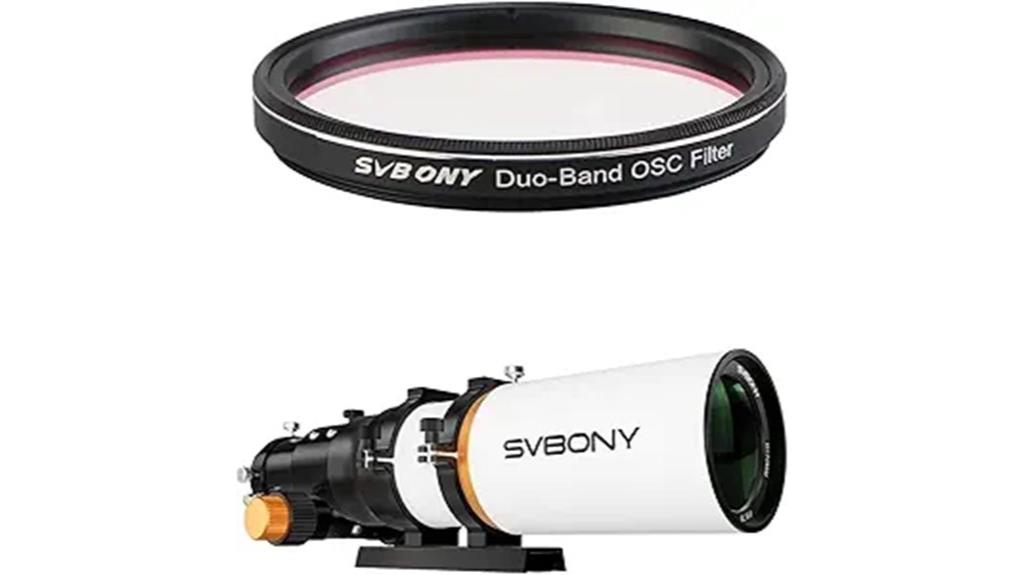
The SVBONY SV220 Dual-Band Nebula Filter paired with the SV503 70mm Refractor Telescope is an excellent choice for astrophotographers seeking to capture detailed images of emission nebulae and other deep-sky objects, even under light-polluted skies. This setup enhances contrast and detail by filtering out unwanted light pollution from moonlight and artificial sources. The telescope’s built-in field flattener ensures sharp, wide-field images free from distortion, while the filter’s high transmission improves visibility of gaseous nebulae and supernova remnants. Together, they deliver vibrant, true-to-life colors and crisp details, making astrophotography more rewarding in challenging conditions.
Best For: amateur astrophotographers and stargazing enthusiasts seeking to capture detailed deep-sky images, especially in light-polluted environments.
Pros:
- Enhances contrast and detail of emission nebulae, planetary nebulae, and supernova remnants.
- Built-in field flattener provides wide, flat-field images with minimal distortion.
- High transmission filter effectively reduces light pollution from natural and artificial sources.
Cons:
- Designed specifically for the SV503 70mm refractor telescope, limiting compatibility with other models.
- Requires additional accessories and setup time for astrophotography sessions.
- Price may be higher compared to single-function filters or basic telescopic setups.
Factors to Consider When Choosing Field Flatteners for Refractor Telescopes
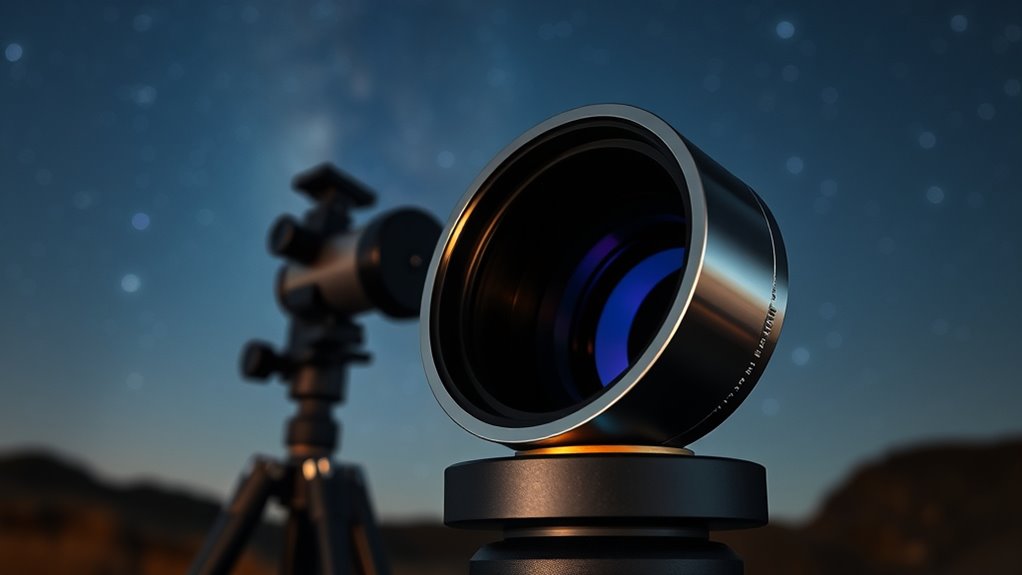
When choosing a field flattener, I consider several key factors to guarantee ideal performance with my refractor telescope. Compatibility with my f-ratio, the quality of optical coatings, and back focus requirements all affect image quality and ease of use. Additionally, I look at mounting options, connectors, and how the flattener might influence my telescope’s field of view.
Compatibility With F-Ratio
Choosing a field flattener that matches your refractor telescope’s F-ratio is essential for achieving sharp, distortion-free images. Field flatteners are designed to work ideally within specific focal ratio ranges, typically between f/5 and f/7, to correct field curvature effectively. Using a flattener outside its recommended F-ratio can lead to incomplete correction, causing star elongation or distortion at the edges of your images. Many flatteners require precise back focus distances tailored to your telescope’s focal ratio to perform at their best. Compatibility with your F-ratio ensures the optical design can properly manage inherent curvature and aberrations. Selecting a flattener suited to your F-ratio helps maintain consistent image quality, sharpness, and minimal aberrations across the entire sensor or eyepiece field.
Optical Coating Quality
High-quality optical coatings are vital for getting the most from your field flattener, as they directly impact light transmission and image clarity. Fully multi-coated lenses reduce reflections and light loss, resulting in brighter, sharper images. Multi-layer coatings enhance contrast and color fidelity by minimizing internal reflections and stray light within the lens elements. Durable coatings also protect against scratches, dust, and moisture, helping to maintain optical performance over time. The quality of these coatings directly affects how well your field flattener reduces chromatic aberration and field curvature. Properly coated optics ensure maximum sharpness and minimal light scatter across the entire field of view, which is essential for high-precision astrophotography. Investing in well-coated components guarantees consistent, high-quality results over the long term.
Back Focus Requirements
Ensuring the correct back focus distance is vital for getting the best results from your field flattener. Typically, this distance is around 55mm, with a tolerance of plus or minus 2mm, to achieve optimal star sharpness across the frame. If the back focus is too short or too long, you’ll notice residual field curvature, star elongation, or softness at the edges of your images. Measuring from the field flattener’s mounting flange to the camera sensor plane is essential, requiring careful measurement and adjustment. Some flatteners come with adjustable spacers, allowing you to fine-tune the back focus for your specific setup. Maintaining a consistent back focus during setup and imaging ensures a flat, sharp field and the best possible astrophotography results.
Mounting and Connectors
Selecting the right field flattener hinges on its mounting options and connector compatibility. I look for flatteners with matching threads, like M48, M54, or T-ring connections, to guarantee seamless integration with my camera and telescope. Secure attachment methods, such as compression rings or threaded connectors, are essential to prevent misalignment during imaging sessions. I also verify that the back focus distance aligns with my telescope’s requirements, which is vital for achieving perfect focus and a flat field. Compatibility with my telescope’s focal ratio range, especially between f/5 and f/7, is another key factor. Finally, I consider how easy it is to attach adapters or extension tubes, making sure they support my entire optical setup without causing vignetting or focus issues.
Field of View Impact
Choosing the right field flattener is essential because it directly affects the size and clarity of your astrophotography images. A good flattener expands your usable field of view by correcting optical distortions, letting you capture wider, more detailed frames. It maintains star sharpness across the entire image, preventing edge distortions and vignetting that can limit your framing options. The impact on your field of view is significant—an effective flattener ensures you don’t lose valuable image area or detail at the edges. Using a flattener designed for your telescope’s focal ratio helps preserve the native field of view and image quality. Conversely, a poorly matched flattener can cause vignetting or reduce the effective view, restricting your astrophotography projects and limiting your creative potential.
Frequently Asked Questions
How Does a Field Flattener Impact Image Distortion in Astrophotography?
A field flattener considerably reduces image distortion by correcting the curvature that naturally occurs in a telescope’s field of view. When I use one, I notice sharper, more evenly focused stars across the entire frame, especially at the edges. It helps me capture cleaner astrophotographs without the need for extensive post-processing. Overall, it’s an essential tool that enhances image quality and makes my astrophotography sessions more successful.
Can a Field Flattener Be Used With All Refractor Telescope Models?
A field flattener can be used with most refractor telescopes, but not all. I recommend checking your specific model’s compatibility because some telescopes may require different accessories or adjustments. Generally, if your refractor has a long focal length or a curved image plane, a flattener will help improve image quality. Always make sure the flattener is designed for your telescope’s aperture and focal ratio for the best results.
What Maintenance Is Required for Field Flatteners Over Time?
Think of a field flattener as a trusty sidekick, needing some TLC over time. I regularly check for dust and dirt on the lens elements, gently clean them with appropriate materials, and guarantee all screws and connections stay secure. Additionally, I inspect for any signs of wear or damage, and I store it in a protective case when not in use. Proper maintenance keeps my images sharp and my equipment in prime condition.
How Do I Properly Align a Field Flattener With My Telescope?
To properly align a field flattener, I start by attaching it securely to my telescope’s focuser. Then, I insert a well-focused star or a test pattern at the center of my camera’s view. I adjust the flattener’s position or tilt until the stars are sharp and round across the entire field. I double-check the alignment at different focal lengths, ensuring consistent sharpness and minimal distortion.
Are There Compatibility Issues Between Field Flatteners and Specific Camera Types?
Did you know that over 60% of astrophotographers face compatibility issues between their camera and field flatteners? I’ve found that most flatteners work best with specific camera types, especially when considering sensor size and connection ports. I always double-check the manufacturer’s recommendations to prevent vignetting or image distortions. Matching the right flattener with your camera guarantees sharp, flat images, making your astrophotography even more stunning.
Conclusion
In my experience, choosing the right field flattener can totally transform your astrophotography—it’s like opening a secret portal to crystal-clear, perfect stars across the entire sky! With these top options, you’ll be capturing stunning images that make your friends believe you’re a space wizard. Don’t settle for blurry or distorted shots—gear up with one of these flatteners and prepare to unleash celestial perfection that’ll blow your mind!
